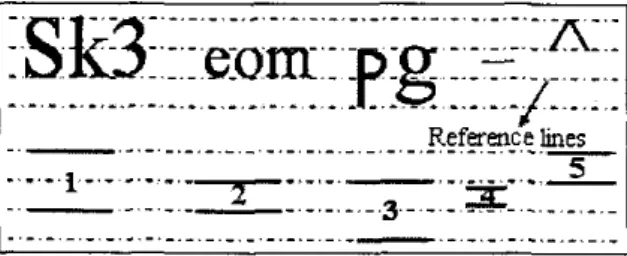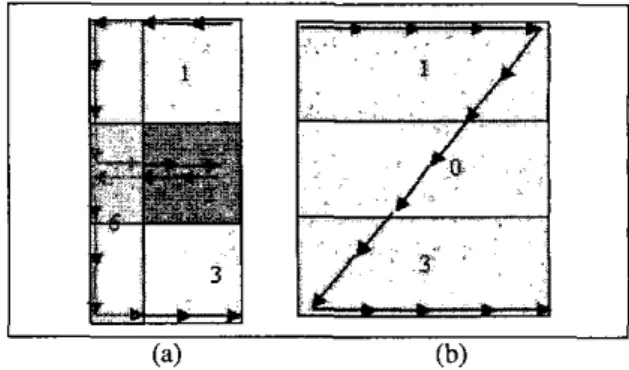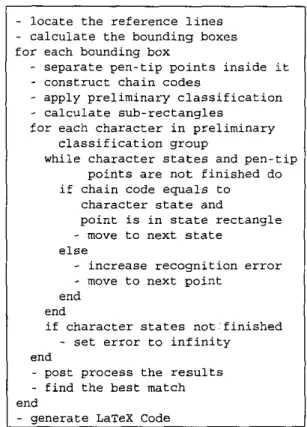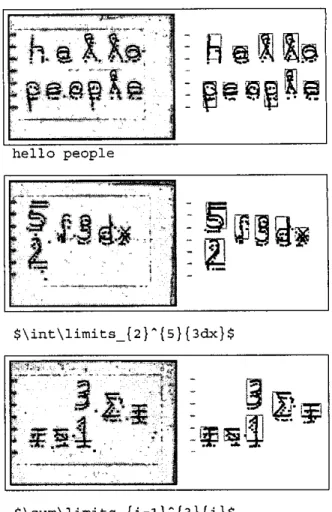2004 IEEE International Conference on Multimedia and Expo (ICME)
Ozcan Oksiiz, U j u r
Giidiikbay
Dept.
of
Computer
Eng.
Bilkent University
06800 Bilkent Ankara Turkey
{
oksuz,gudukbay} @cs.bilkent.edu.tr
Ahsrract
-
In this paper. we present a computer vi- sion based text and equation editor forLT@.
The user writes text and equations on paper and a camera at- tached to a computer records actions of the user.In
particular, positions of the pen-tip in consecutive im- age frames are detected. Next, directional and posi- tional information about characters are calculated us- ing these positions. Then, this information is used
for
on-line character classification. After characters and symbols are found, corresponding Le# code is gen- erated.
1. INTRODUCTION
In this paper, we present
a
computer vision based text and equation editor for L q s . In this system, the user writes text and equations on paper and a camera at- tached to a computerrecords actions of the user. Writ- ten characters are recognized on-line and the corre- sponding LT@ code is generated at the end of each page. Handwriting recognition can he classified into two categories, on-line and off-line, which differ in the form the data is presented to the system. On-line recognition has some benefits over off-line recogni- tion, mostly due to the extended amount of informa- tion that is obtainable. In addition to the spatial prop-erties o f the stylus, also the number of strokes, their order, the direction of writing for each stroke, and the speed of writing are available. Another advantage of on-line recognition is that there is close interaction he- tween the user and the machine. The user can thus cor- rect any recognition error immediately when it occurs. Moreover, on-line handwriting recognition promises to provide a dynamic means of communication with computers through a pen-like stylus, not just a key- board. This seems to he a more natural way of entering data into computers [ I , 2 , 4 , 5 , 61.
In
our
system the user writes on a regular paper or aThis work is pilnivlly supponed by Europevn Commission 6th Fmework P r o g m with grant number FP6-507752 (MUSCLE Network of Excellence Project) and by Turkish State Planning Or-
ganizalion (DIT) with grant number 2WK120720.
COMPUTER VISION BASED
TEXT AND EQUATION EDITOR
FOR
BTG
0-7803-8603-5/04/$20.00 02004 IEEE
1255
Enis Getin
Dept. of Electrical and Electronics
Eng.
Bilkent University
06800
Bilkent Ankara Turkey
cetin @ee.bilkent.edu.tr
white board and a USB CCD camera attached to the computer captures the video while he or she writes characters. We detect the pen-tips in image frame and determine the bounding boxes of each character. Then chain and region codes are calculated and characters are recognized. Finally,
L#rEx
codes corresponding to the recognized characters are generated.The rest of the paper is organized as follows: first, key features of our character recognition system are ex- plained. Next, experiments conducted and their results are shown. Finally, conclusions are given.
2. CHARACTER RECOGNITION SYSTEM 2.1. Preliminary Classification
In our recognition system it is assumed that whole paragraphs or documents are written on a stripped pa- per, one line at a time. In addition, each line is divided into 3 strips formed by
4
reference lines. By usingthese reference lines the need for character size nor- malization is eliminated and the classification of letters is performed by using relative positions of them in the three-strip frame. By performing preliminary classifi- cation we tried to reduce the number of possible candi- dates for an unknown character to a subset of the total character set. For this purpose, the selected domain is categorized into five groups as shown in Figure 1. Table 1 lists all the characters allowed in our system, classified into the five pre-classification groups.
Figure 1 : Reference lines and possible locations of five character groups.
Table 1: Characters in five groups
2.2. Chain codes
The user writes the characters using an ordiniuy board marker having black color. In order to trace the pen movements easily, a blue band is attached near its tip and at each frame the position of this blue band is recorded. After pen tip points are found they are pro- cesscd for chain code extraction. A chain code is a sequence of numbers between 0 and 7 obtained from the quantized angle of the pen tip’s point in an equally
ing box are used during the classification period. First of all, each calculated bounding box is divided into sub-rectangles. Bounding boxes belonging to the char- acter &roups 1 and 3 arc divided into 9 different sub- rectangles, and bounding boxes belonging to the char- acter groups 2 and 5 are divided into 5 sub-rectangles, as shown in Figure 3. Then, region coded represen- tation of each character is described using the idea that each separate character stroke should be described with minimum bounding sub-rectanglc, as shown in Figure 4.
timed manner. Chain code values for angles and chain ( 0 )
Figure 3: Bounding box sub-rectangles preclassifica- tion grouDs. (a) 1 and 3. (b) 2 and 5
coded representation of character E are shown in Fig- ure 2.
6
Y
(a) (b)
Figure 2: (a) Chain codes (b) Chain coded representa- (a) (b)
tion of character E=444666000444666000
Figure 4: Region coded representation. (a) E=l I1666222222666333and (b) Z=ll110000003333
2.3. Bounding boxes and their sub-rectangles
After characters are written, the last image of the video
is
converted into a binan imam using thresholdine.-
-
I 2.4. Finitestate
Machines Then, this hinary image is processed to determine thehounding box ofeach character, which is the minimum rectangle enclosing the written character. Bounding boxes are used to distinguish each character’s coordi- nates on the paper. Then using these coordinates each character’s movement points are separated and corre- sponding chain codes are calculated.
The recognition system consists of Finite State
Ma-
chines (FSMs) corresponding to individual characters. Separated chain codes and calculated region codes are inputs to the FSM. The FSMs generating the minimum error identifies the recognized character. The weighted sum of the error from a finite state machine determines the final error for a character in the recognition pro- Pen movement points have another usage different from
chain code generation. Their positions in the bound-
cess. Finite state machines for some characters are shown in Figure 5 .
(h)
Figure 5: Finite State Machines, where C
=
Chain Code, R = Region Code. (a) M and (h)Here is an example showing how FSMs work in our system. When the 23222217771 I17666 chain code and the 44444441 1221 15555 region code are applied as an input to M’s machine, the first element of chain
2 and region 4 are correct values at the FSM’s start- ing state. Therefore, FSM is started with error coont 0. The second element of chain 3 generates an error and the error counter is set to I . The FSM remains in the first state with other 2s of chain and 4s of region code values. It remains at the same state with the suh- sequent I since 1 and 2 are the inputs of the machine’s first state for
M.
Input of chain code 7 and region code 1 makes the FSM go to the next state, and the subse- quent chain codes of three 7s and the region codes ofI and 2 make the machine remain there. Whenever the chain code becomes 1 and the region code becomes 2,
the FSM moves to the third state. The machine stays in this state until the chain code
is
7 andregion
code is5,
and this makes FSM go to the final state. The rest of the input data, chain 6 and region 5, makes the machine stay in the final state, and when the input is finished, the FSM terminates. For this input sequence, the machine’s error for character M is 1. However, the other FSMs generate either greater or infinite error values for this input.2.5. Steps of the Character Recognition Algorithm
The character recognition algorithm is given as pseudo- code in Figure 6. The overall operation does not take long in a PC. Because the character recognition pro-
cess is an O(N) operation
[31.
After characters are recognized, they are passed to LWEX
code generation procedure. Some character comhina-
-
locate the reference lines- calculate the bounding boxes
for each bounding box
-
separate pen-tip points inside it-
construct chain codes-
apply preliminary classification-
calculate sub-rectangles for each character in preliminaryclassification group
while character states and pen-ti€ points are not finished do if chain code equals to
character state and
point is in state rectangle
-
move to next state-
increase recognition error-
move to next point elseend end
if character states not finished
-
set error to infinity end- post process the results
-
find the best match end- generate LaTeX Code
Figure 6: The character recognition algorithm
tions are used for L F j keyword generation. Some characters have different effects in different environ- ments. Supported LTEX environments are m a y con- struction, citation, section, itemization, equation and normal text environment. Character combination and corresponding
L F j
codes are shown in Table 2.3. EXPERIMENTS
In our experiments we use an ordinary hoard marker having black color and we attached a blue band near its tip for detection of the pen tip while characters are drawn. We write characters on white A4 paper or a white board, which is assumed to have stripes on it. Consecutive frames are captured using a USB CCD camera that can capture 6.3 frames per second with
320 x 240 pixels. A PC with AMD Athlon 1400 pro- cessor with 256 Mhytes of memory is used during recog- nition for
all
processing.To test the system, we used at least 20 samples for each character and a total of 2170 characters. The system requires 15 image frames per character. The system handles I O characters per minute.
This
rate can heim-
proved by using a high resolution camera with a het- ter frame grabber. After conducting experiments, we reached a 90% recognition rate at a writing speed of ahout
IO
characters per minute. The main recognitionU
Characters\
in itemize mode >i C S \item end{itemize} \section{n
>Sii
n
Table
2:
Character groups andBTfl
codeserrors were due to the inaccurate writing habits and ambiguity among similar shaped characters. Most of the confusion was between character pairs such as
“e”
and “c”, “5” and “ S , and “U” and “v”. This could be avoided by using a dictionary to look-up for possible character compositions. The presence of contextual knowledge will help to eliminate the ambiguity. In Figure 7, some examples characters and their
Lqfl
codes are given. In this figure, there are 2 columns: (a) this is the last frame captured during character are written. The pen movement points are shown with blue color. (b) bounding boxes and pen trace points falling within each bounding box.
4. CONCLUSION
In
this paper, we present a computer vision based text and equation editor for L W j . The user writes text and equations on paper anda
camera attached toa
com- puter records actions of the user.The results
show
a
90%
correct recognition rate.The
main recognition errors are due to the inaccurate writ- ing habits and ambiguity among similar shaped char- acters. This could be avoided by using
a
word dic- tionary to look-up for possible character compositions or usinga
pop-up menu for confused characters. The presence of contextual knowledge will help to elimi- nate the ambiguity.The recognition accuracy can be increased using
a
high rate frame grabber, acquiring25-30
frames per second. The USB camera can provide 6-7 frames per second, which reduces the accuracy of the chain codes. The reason that we use a USB camera in our system is to realize a low-cost system with standard equipment.-
hello people$\sum\limits-(i=1)^(3)(i}$
Figure 7: Examples and corresponding L W j codes.
5. REFERENCES
[I] H. Bunke, T. von Siebenthal, T. Yamasaki and M. Schenkel. “Online handwriting data acquisition us- ing a video camera”, In Proc. of Int. Conj on Docu- menr Analysis and Recognition, pp. 573.576, 1999. [2] X. Li and
D.
Y. Yeung, “On-line handwritten al- phanumeric character recognition using dominant points in strokes”, Parrem Recognition, Vol. 30, No. 1, pp. 31-44, 1997.[3] 0. E Ozer, 0. Ozun. C. 0. Tiizel, V. Atalay and A. E. Cetin, “Vision-Based Single-Stroke Character Recognition for Wearable Computing”. IEEE Inrel-
ligent Systems. Vol. 16, pp. 33-37, 2001.
(41
S.
Smithies. K. Novins and I. Arvo, “A handwriting- based equation editor.”, In Pmc. of Graphic Inter- face, pp. 84-91, 1999.[SI X. Tang and E Lin, “Video-based Handwritten Char- acter Recognition”, Pmc. of IEEE ICASSP. 2002. [6] M. Wienecke, G. A. Fink and G. Sagerer, “Video-
based on-line handwriting recognition”. In Pmc. of Int. Con$ on Document Analysis and Recognition,
pp. 226-230, 2001.



